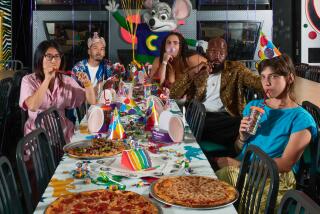Special Vocabulary of the Teen Years
- Share via
Written records demonstrate that for more than 300 years, humans from 13 through 19 years of age have been said to be in their teens. Most of us know that the guy who lost his girlfriend to the daring young man on the flying trapeze was “betrayed by a maid in her teens.” But I think the expression teen-ager didn’t exist before the 1940s.
Strange to say, this thought stemmed from a conversation about Cary Grant. How can one’s thoughts meander along a philological path from someone as classy as Cary Grant to teen-agers, especially as exemplified by Henry Aldrich, Corliss Archer and her adolescent idolater, Dexter Franklin? Cary Grant epitomized masculine charm, grace and robustious humor. I suppose no one under 40 remembers Henry Aldrich and Corliss Archer, much less Dexter Franklin, but they were among the original “teen-agers” and the leading characters of Broadway shows, radio series and films of the 1940s. They embodied a certain ungainly charm, very little grace, and humor less robustious than merely raucous, which is not at all the same thing.
In a dazzling display of unchecked woolgathering while rambling along a curious trail of words, my mind went from the sublime Cary to the ridiculous Henry, Corliss and Dexter.
My flight to never-never land took off just after I had talked on the phone with my friend Ruth Phillips. We had reminisced briefly about Cary Grant. I suppose everyone has memories of at least a couple of Cary Grant’s great movie scenes, and we swapped a few.
My all-time favorite was from “Gunga Din.” It’s the scene in a temple, where a few hundred Thugs--a fraternity of murderers and thieves, practitioners of Thuggee, who worshipped Kali--are heavily armed and being worked to a frenzy by Eduardo Ciannelli. Ciannelli is sitting cross-legged on a raised platform, the crescent whites of his eyes giving him a look of inexorable evil, as he growls, “Kill! Kill for the love of Kali! Kill for the love of killing! Kill! Kill! Kill!” The Thugs get swept up in the hypnotic chant, and they raise their rifles and scream what we must suppose are savage obscenities. Into this barbaric maelstrom strides Cary Grant, all by himself, with that superb swagger of his, shouting, “All right! You’re all under arrest! Drop your guns and follow me!” as he elbows his way through the madding crowd.
I think the next cut shows him held by the arms at the brink of a pit filled with an unruly gathering of restless cobras. I can’t recall how he’s extricated from his predicament, but that scene is unforgettable.
The film is based loosely and with wildly imaginative digressions on Kipling’s poem. Ruth told me “Gunga Din” had been one of her late father’s favorite poems, and I told her it had been one of my favorites when I was in my early teens, but that I hadn’t read it in well over 40 years. So, after I hung up, I pulled out my ancient, tattered, morocco-bound “Works of Kipling” and reread “Gunga Din” (“Now in Injia’s sunny clime, / Where I used to spend my time / A-servin’ of ‘Er Majesty the Queen . . .”)
I had forgotten what a lot of strange expressions it held. The first is “Water! get it! Panee lao!” which is footnoted as “Bring water swiftly.” Then there’s “We shouted “Harry By!’ / Till our throats were brick dry.” The footnote says Harry By! is “Mr. Atkins’ equivalent for O brother. “ This one threw me for ‘arf a mo. In my mind, I pronounced it as “Oh, Brother!”--the common American term of exasperation or wonderment, whereas I feel sure that what Tommy Atkins intended was surely a cry to get the water-boy’s attention. I think that today, “Harry By!” would more aptly be termed Atkins’ equivalent for something like, “Hey, Mac!” or “Over here, Buddy!”
I started thinking about the inanity of the expression Oh, Brother! and wondering how it ever came into being and what similar dumb phrases we use. Almost immediately, Henry Aldrich and Dexter Franklin got together in my head with a duet of “Holy Cow!” which was, presumably, the favorite expletive of hordes of 14-through-17-year-olds of the ‘40s. Personally, I never knew anyone who said “Holy Cow!” but I was out of my teens by 1946, so it might have been a matter of timing.
Anyway, that is how one can bounce haphazardly from Cary Grant through Kipling and “Injia’s sunny clime” (“Injia” being, incidentally, the home of sacred cows) to the wacky world of teen-agers and their holy cows.
Sacred and holy are very nearly synonymous, but sacred cows and holy cows are not at all the same things.
More to Read
Only good movies
Get the Indie Focus newsletter, Mark Olsen's weekly guide to the world of cinema.
You may occasionally receive promotional content from the Los Angeles Times.










